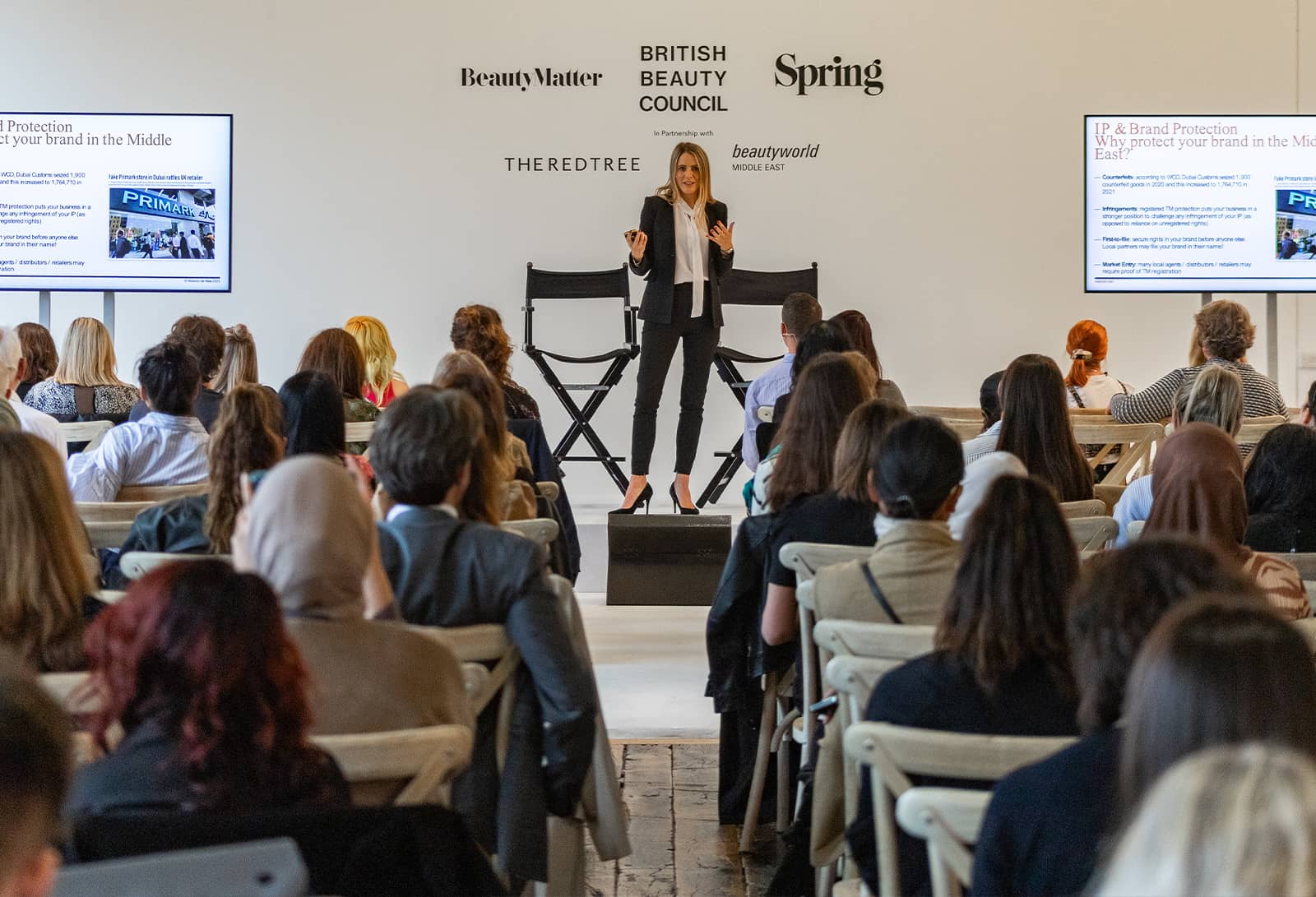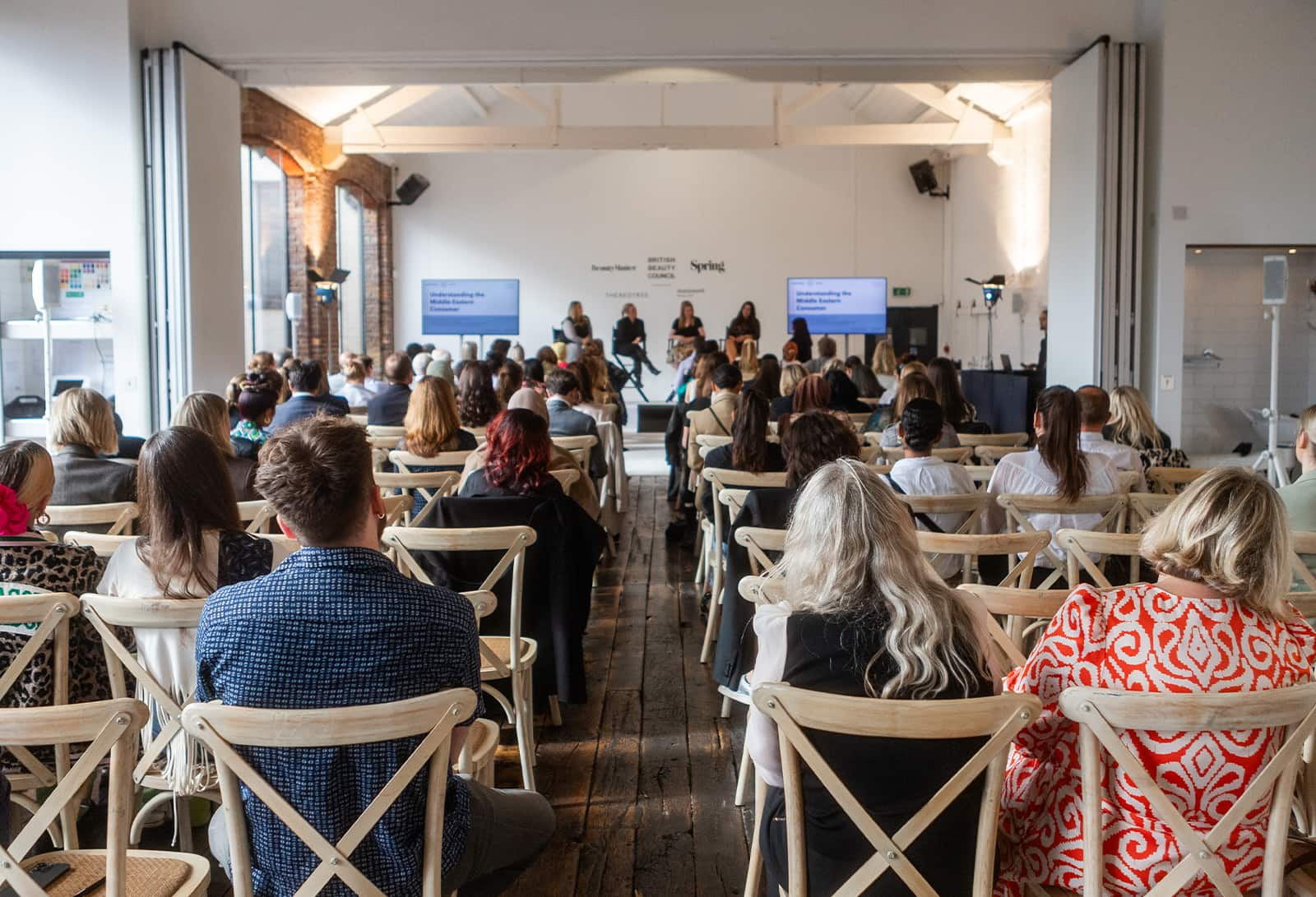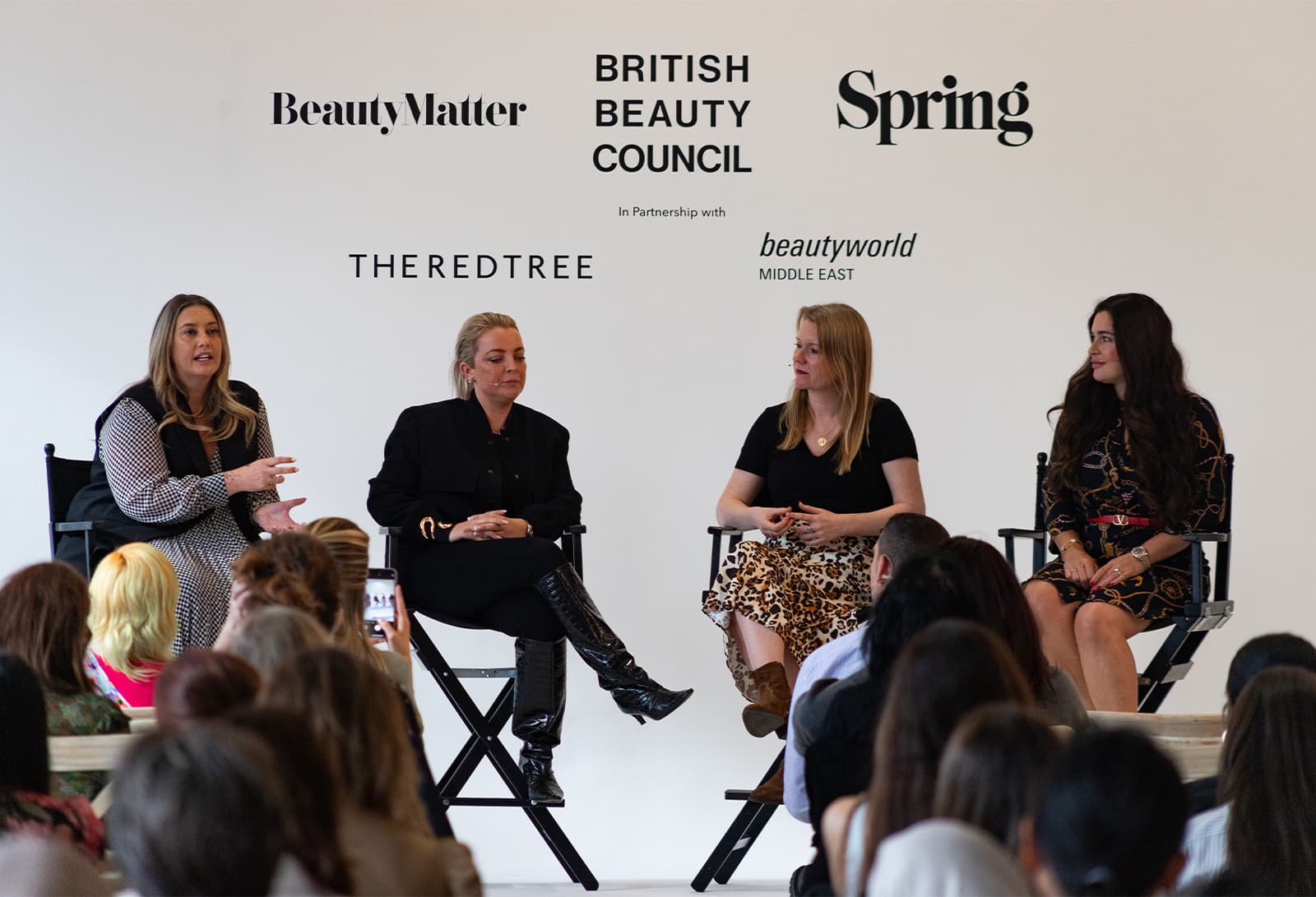Following their highly successful London summit in February exploring the Chinese beauty market, BeautyMatter and the British Beauty Council (BBC) got together again—along with communications agency Spring—to find out more about another region that remains a mystery to many: the Middle East.
The conference, called Deep Dive: The Middle East Beauty Opportunity, gave attendees valuable insights into the best ways to crack open a market (including Africa) that international beauty consultancy, The Red Tree, says will be worth about $47 billion by 2027.
Fiona Glen, Head of Projects at The Red Tree, opened with some other appealing stats including, for example, that the average age in Saudi Arabia is just 32; expats make up 75% of the population in the United Arab Emirates (UAE); and that populations in some markets are large—84 million in Turkey, and 36 million in Saudi Arabia. Saudi Arabia also has impressive digital consumption at 82%, one of the highest in the world.
However, Glen warned: “It isn't as simple as thinking Saudi has a really big population, so I've got to be there. You have to dig into the demographics, media usage, and then overlay aspects of culture.”
She admitted that getting accurate and consistent data for the Middle East was difficult, partly because the region is ill-defined; sometimes grouped with Africa, sometimes the numbers are for MENA (Middle East & North Africa), or for the six GCC (Gulf Cooperation Council) countries. “The region is intricate and fragmented,” she added.
McKinsey data for MENA show that fragrance and haircare are the go-tos with projected sales by 2027 of $5.4 billion and $6.1 billion, and CAGR growth rates of 11% and 12%, respectively. Only Western Europe will have higher fragrance sales, and only North America, higher haircare sales.
A notable feature of the numbers is that MENA will be the sole global region to have double-digit growth from 2022-27 across all beauty segments: fragrance, color cosmetics, haircare, and skincare at 11%-12%. This is a big opportunity for newcomer brands.
For them, the route to market is crucial. Glen outlined six channels ranging from offline retail, e-commerce, and D2C (direct-to-consumer) to spas, salons, and clinics. “Spa is huge in the Middle East and a key distribution channel, and similarly the salon. Culturally it is a social thing that people do together on a weekly basis, like people might go to the pub in the UK.”
Strategies within Strategies
The Red Tree’s Amy Ward, a brand consultant in the Middle East, added: “The Middle East has so many nuances by country. You may find you need strategies within strategies, and this can affect your timeline or budgeting.”
She said that while the region does “do luxury very well,” and there are some amazing brand names in the market, the streets are not necessarily paved with gold. Consumers are price sensitive, and “they really do know how to check that they are getting value for money.”
As for operating models, there are essentially three: distributor; brand-operated and joint venture; or direct-to-retailer exclusives. Ward noted: “Typically brands have a distributor. This is not simply a wholesale partner. In the Middle East, you are essentially signing your business over and they are managing your brand in its entirety in the region—they have a lot of control.”
Choosing the wrong distributor can be costly in terms of potentially having to pull out and clean up the market afterwards. So getting this relationship right from the start is critical. Ward cited some examples where it has worked very well: Dr. Barbara Sturm; 111 Skin, initially in spas before moving into retail; and Anastasia Beverly Hills, one of the first international brands to “just take over the market.”
A joint venture path, with players like Chalhoub or Al Tayer, can also be fruitful, and a good example is Charlotte Tilbury, a brand several speakers mentioned in their presentations. Ward said, “To the consumer, Charlotte Tilbury is, in every way, independent but is actually an Alshaya partner, which has given it immediate access to key mall locations and power in the market.”
Other brands like The Ordinary and Sunday Riley have entered exclusively via Sephora with some success, but will likely remain tied to the retailer. Department stores are not a huge opportunity in terms of volume sales, but they do “create great brand curiosity” according to Ward.
In answer to a question from BeautyMatter President John Cafarelli about the non-luxury opportunity, Ward said that pharmacy offers a volume route in, as does e-commerce. She said that while the market is luxury heavy, there is room at the value end of the spectrum, but brands need to make decisions on their positioning before taking that path.



Tracking the Consumer
Understanding the consumers is also paramount. In summer, a large percentage of people leave the country for at least a month. They are often in London, New York, or Paris, and learn a lot about the brands they want while traveling. This then affects demand back home.
Also driving demand are social media channels; it may be Tik Tok in one market or Snapchat in another, with influencers having a powerful role.
“The Middle East is not a place where you launch to help your brand get going,” said Ward. “You need to be clear about what you brand is about.” She added that the typical place to start in the region is Dubai, but Kuwait has one of the highest spends on beauty plus a well-traveled population, so a high-end brand could focus there first.
Saudi Arabia holds a lot of promise over the next few years, but it comes with some downsides too, in particular when it comes to strict visual marketing and advertising standards. In cases where a brand can’t get its message across through images, influencers can be a useful aide.
Legal and regulatory considerations can also be challenging in the region.Eloise Harding, Managing Associate at law firm Mishcon de Reya, laid bare the intellectual property (IP) and brand protection landscape. The registration process can be as short as three to four months in the UAE and Saudi Arabia, but up to two years in Qatar.
While some markets (Bahrain, Oman, UAE) are signatories to the Madrid System for international trademark protection, it is generally advised that brands file across all territories. Turkey was flagged as a key market to secure trademark protection as it as “a counterfeit hub,” according to Harding.
The process might be onerous, but it offers security. Trademarks also become vulnerable for nonuse, the time period being 3-5 years depending on the market, so brands need to think carefully about when they file and not do it too early. Trademark applications are often also required before distributors and retailers will work with a brand.
In a panel session titled Understanding the Middle Eastern Consumer, an interesting discussion was had between Flyn Roberts, Consumer Portfolio Director at exhibition organizer Messe Frankfurt Middle East; Bridey-Rae Lipscombe, CEO and Co-Founder of Cult; Wizz Selvey, Founder of Wizz & Co; and Dr. Bibi Ghalaie, Founder and Medical Director at Doctor Bibi Clinic. Moderating was BeautyMatter Founder Kelly Kovack.
Key takeaways from the discourse were that Middle East consumers were very astute and well researched; that clean and organic beauty and beauty tech were popular; men’s spending on fragrance was higher than women’s; and skincare was growing quickly.
Enhancing Natural Ethnicity
Ghalaie also noted: “In many cases consumers are looking to heighten their features and preserve their natural ethnicity rather than change it. In the past 20 years Middle East women have become progressive and bold and look for an understated beauty, not something that’s in your face.” This favors brands that are localizing their product offers to fit specific demands, according to Lipscombe. “It is Arabic beauty ideals that matter,” she said.
Even Amazon has taken this onboard in the region by sourcing locally. Having acquired e-commerce retailer Souq.com in 2017 for $600 million, the company has built up a bigger distribution presence with country-specific sites for Turkey, the UAE, Saudi Arabia, and most recently, Egypt.
Renee Parker, Co-Founder of Invinci, a consultancy “addressing the Amazon opportunity,” said, “Amazon is the fourth-largest online retailer in the region. It invests in ‘customer trust’ initiatives.”
She suggested that beauty brands approach the e-commerce giant from a “defensive or protective” position. Whether you sell on Amazon or not in any region in the world, she said that registering your trademarks on the e-retailer’s brand registry online was a good idea.
While Amazon may not be the biggest e-commerce player in the region, Parker said that it is a research portal and therefore an education opportunity for brands, especially when trying to reach younger digital natives.
The final two sessions of the day offered plenty of insights into how beauty brands, both domestic and international, have succeeded in the region and the different strategies they have used.
Multiple Brand Strategies at Play
A brand panel consisting of Maria Hatzistefanis, founder of Rodial Group; Aleena Kahn, co-founder of CTZN Cosmetics; and Lucy Goff, founder of wellness brand Lyma, first discussed their preferred model for development, led by moderator Carla Seipp, a BeautyMatter editor.
Hatzistefanis said that for Rodial, with its luxury positioning, the distributor model has worked best, taking the brand into some flagship department stores in the region. “There are more costs but you can really shout about your product,” she said.
In contrast, Goff admitted that the distributor model did not work for Lyma, and she took the clinic-first approach due to the scientific nature of her products. “We use brand ambassadors in key clinics and they have a lot of impact,” she said.
A strategy that has worked well for CTZN has been to first build a presence in the United States and Europe and develop some excitement among millennials and Gen Z that way in the region, according to the brand’s founder Khan.
Closing the day was a discussion between Sara Al Rashed, Founder of Arabian homegrown brand Asteri (meaning "stars" in Greek) and design consultant Dalziel & Pow Creative Director Sarah Fairhurst. The latter company has supported Al Rashed’s vision of "Sisters Under the Stars."
Al Rashed said that while her brand was “culturally authentic”—with lipsticks named after Saudi women to underline that focus, for example—it was nonetheless a digital-first, D2C brand “which gives us control of the narrative.”
Fairhurst said that in helping to developing Asteri, Dalziel & Pow was sensitive to the idea of a brand that was deeply rooted with a sense of place, and created by, and for, the modern Arab woman. With such a strong story behind it, Asteri has the credentials to take Arab beauty to the global stage.